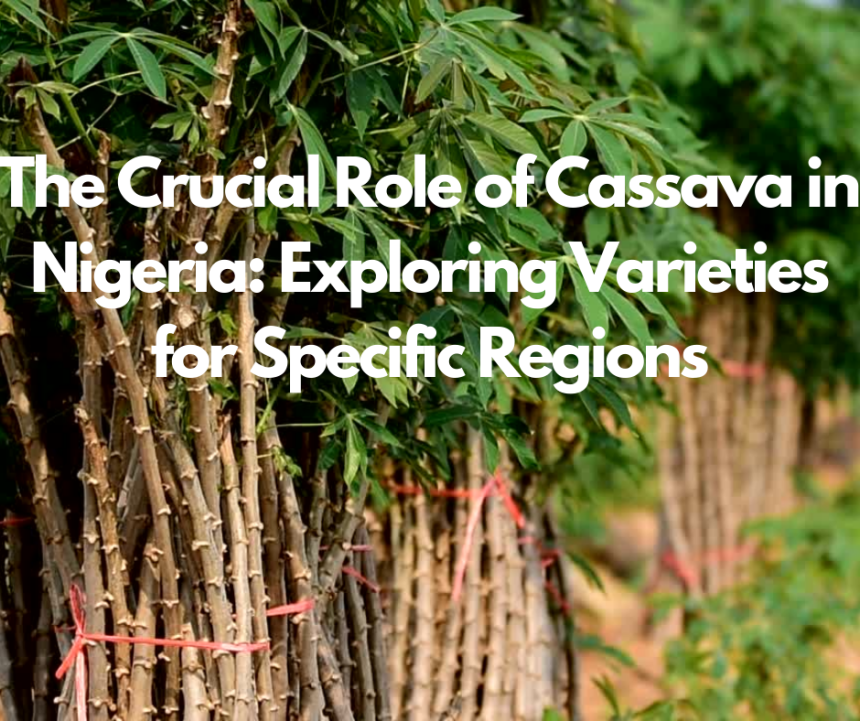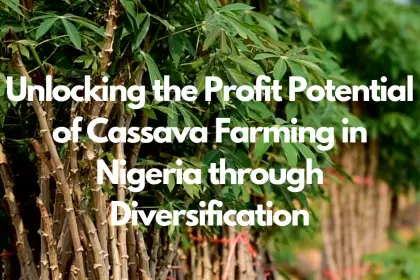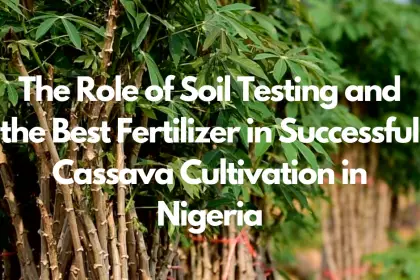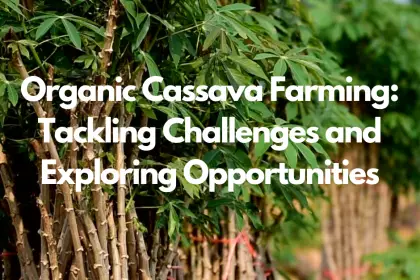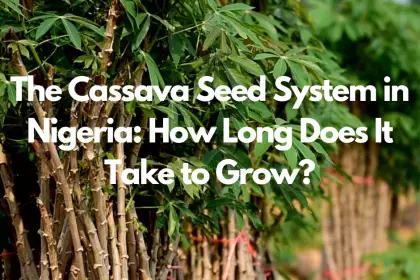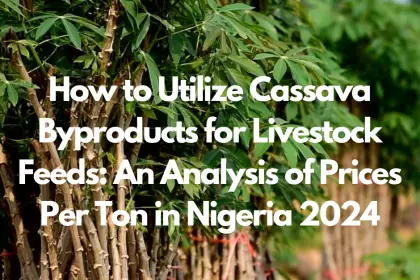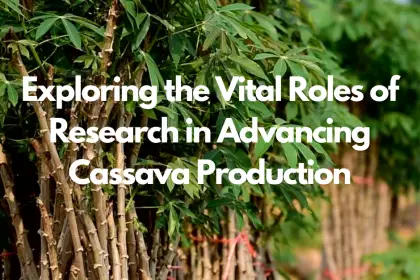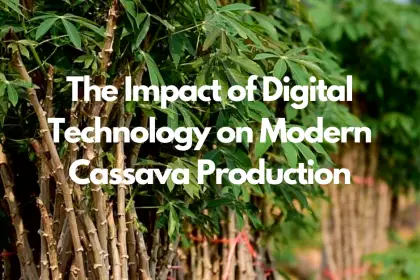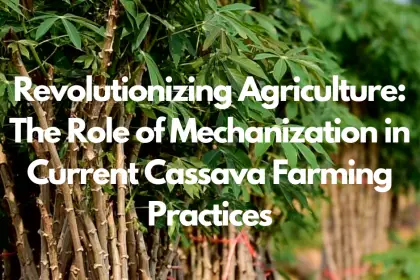Cassava, pivotal to the rural economy of Nigeria, particularly thrives in the southern agro-ecological zones, underscoring its importance to man through its significant role in both domestic consumption and the gross domestic product (GDP). As the world’s premier producer, with an astounding annual output surpassing 34 million tonnes of tuberous roots, Nigeria highlights the crop’s versatility and essential nature in feeding its rapidly growing population. The starch-rich cassava root not only serves as a fundamental source of energy but also as an alternative to wheat and bulgur, offering a viable option for those with allergic reactions to these grains.
The cultivation of cassava, primarily managed by small-scale farmers employing basic implements, faces challenges such as initial capital and land availability, yet remains a key contributor to Nigeria’s economy. Efforts to amplify production for export purposes are underscored by government intervention and the development of over 40 varieties adapted to various regions, demonstrating a concerted push towards self-sufficiency and reduced reliance on rice and wheat imports. This introduction sets the stage for an exploration of the diverse cassava varieties across Nigerian regions, their impact on processing and end-products, and the pivotal role of gender and farmer experiences in shaping the cultivation and utilization of this crucial crop.
Cassava Variety Preferences Across Nigerian Regions
In Nigeria, the BASICS-II Project has been instrumental in promoting eleven top-performing cassava varieties, each with unique characteristics tailored to meet the diverse climatic conditions and processing needs across the country. Here’s a closer look at some of these varieties:
- Ayaya (CR36-5, IBA961632, Farmer’s Pride)
-
- Yield Potential: 35 tons per hectare
- Features: Drought and CMD tolerant, multiple pest resistant, excellent for flour and starch production
- Physical Attributes: Stable dry matter, purple petiole, light brown stem, white root
- Fine Face (IBA070593, Sunshine)
-
- Yield Potential: 34 tons per hectare
- Features: CMD resistant, low cyanide potential, excellent for garri production
- Physical Attributes: Attractive umbrella shape, white root
- TME419 (TMEB419)
-
- Yield Potential: 36 tons per hectare
- Features: Suitable for all Nigerian ecologies, CMD resistant, low cyanide potential, excellent for mechanization
- Physical Attributes: 40% dry matter content, erect, straight type, green petiole, light brown stem, light/cream root
- Dixon (TMS13F1160P0004, Game Changer) and Obasanjo-2 (NR130124, Hope)
-
- Yield Potential: 38 and 38.7 tons per hectare, respectively
- Features: High starch and dry matter content, multiple pests and disease resistance, excellent for starch and flour production
- Physical Attributes: Compact branch type, good root shape, low water content for Dixon; good umbrella plant types, greenish purple petiole, silver brown stems for Obasanjo-2These varieties, developed through genomics-assisted breeding and consumer preference studies, not only promise high yields but also cater to the specific preferences of farmers, processors, and consumers. They exhibit resistance to pests like cassava mosaic disease (CMD) and possess the right color and texture for meal preparation, ensuring broad acceptability and improved food security and livelihoods for Nigerian farmers.
Gender Perspectives on Cassava Varieties
In exploring the gender perspectives on cassava varieties within Nigeria, it becomes evident that preferences and challenges differ markedly between men and women, influenced by a variety of factors including region, religion, and socio-economic status.
- Trait Preferences:
-
- Men prioritize agronomic traits such as high yield, early maturity, and large root size, which are crucial for maximizing production efficiency.
- Women, on the other hand, focus on product quality and cooking traits, emphasizing the importance of cassava varieties that are easy to peel and have desirable cooking qualities.
- Access and Constraints:
-
- Access to planting material is more restricted for women, limiting their ability to engage in cassava cultivation to the same extent as men.
- Women face significant constraints such as low product prices, high costs of processing equipment, poor market infrastructure, and exploitation by middlemen, which men are less affected by.
- Participation and Empowerment:
-
- Despite these challenges, women are more involved in cassava production activities, with their level of involvement influenced by marital status, farming experience, and education.
- Policies and programs that address gender-specific needs and constraints can contribute significantly to food security equity and the empowerment of women in the cassava value chain.This analysis underscores the importance of incorporating gender considerations into cassava cultivation and processing strategies to ensure that interventions are equitable and effectively support the needs of both men and women in Nigeria.
Seed Dissemination and Access to Improved Varieties
Farmers’ engagement in community or cooperative organizations significantly enhances their likelihood of utilizing improved cassava varieties, highlighting the importance of collective action in agricultural innovation. Training sessions for both farmers and processors, facilitated through Research for Development (R4D) programs, have been pivotal in broadening the adoption of these improved technologies, demonstrating the critical role of education and capacity building in agricultural advancement.
Key initiatives for seed dissemination and access to improved cassava varieties include:
- The Integrated Cassava Project (ICP) and the African Cassava Agronomy Initiative (ACAI) project, which play crucial roles in introducing and promoting high-yielding, disease-resistant cassava varieties through a network of National Agricultural Research Services (NARs), Agricultural Development Programs (ADPs), seed companies, and extension agents.
- The BASICS-II project and IITA GoSeed, which aim to create a commercially viable seed value chain, providing farmers with access to affordable, quality-assured seeds of improved varieties. These efforts are supported by innovative technologies such as Semi Autotrophic Hydroponics (SAH) for rapid multiplication of virus-free stems.Despite these advancements, challenges persist, including limited access to clean planting material, low awareness among farmers, and the infancy of formal seed systems, with less than 1% of cassava seed production being formal. Addressing these obstacles is essential for ensuring that the benefits of improved cassava varieties—increased yields, disease resistance, and enhanced food security—are fully realized by Nigerian farmers.
Farmer Experiences with Cassava Varieties
Adopters of improved cassava varieties in Nigeria have demonstrated a significant increase in yield and income, underscoring the pivotal role these varieties play in the agricultural landscape. The following points highlight key findings from studies conducted on farmer experiences with cassava varieties:
- Yield and Income Impact:
-
- Farmers adopting improved cassava varieties report a higher yield of 16 tons/ha compared to non-adopters with 11 tons/ha.
- In the Ohafia agricultural zone of Abia State, adoption of TMS 30572 and NR 8082 resulted in a mean annual income of N30, 340.05 from cassava sales and by-products.
- There is a positive and significant relationship between the adoption of these improved varieties and farmers’ income, indicating enhanced welfare for farm households in Southwestern Nigeria.
- Awareness and Adoption Rates:
-
- A study revealed that 75% of respondents were aware of TMS 30572, with 70% adopting it, while 96% knew of NR 8082, with a 66% adoption rate.
- Disease Resistance and Training Influence:
-
- The threat of Cassava Mosaic Disease (CMD) has prompted initiatives for the dissemination of disease-resistant varieties.
- Villages participating in Research for Development (R4D) training showed a higher yield variation, with 15 tons/ha compared to those not participating (13 tons/ha).These findings reflect the critical importance of improved cassava varieties in boosting productivity and income for Nigerian farmers, contributing significantly to food security and economic stability.
Impact of Cassava Variety on Processing and End-Products
The impact of cassava variety on processing and end-products is multifaceted, encompassing the efficiency of processing methods, the quality of the final products, and their acceptance by consumers. This section delves into how variations in cassava types influence these aspects:
- Processing Efficiency and Machinery:
-
- The promotion of cassava processing machinery, especially graters, has been complemented with training on crop management and the establishment of processing centers. This integration facilitates the efficient processing of cassava into popular products like garri and fufu.
- Local fabricators have been trained in producing and maintaining these processing machines, ensuring sustainability and adaptability to different cassava varieties.
- Consumer Preferences and Cultural Influence:
-
- Consumer preferences and cultural, custom, or tradition significantly affect the consumption pattern of cassava food products (CFPs), with mean scores (MS) of 2.91 and 2.88, respectively.
- To effectively promote CFPs consumption, policies should emphasize respecting culture and providing necessary processing equipment, aligning product attributes with consumer expectations and cultural practices.
- Economic Impact and Youth Engagement:
-
- The production part of the cassava value chain could provide Nigeria with 16 million jobs, spanning farming, distribution and sale of crop inputs, processing, and marketing.
- Viewing agriculture as a business is crucial to encourage the interest of youth, ensuring the sustainability of the cassava industry and its contribution to the economy.
Conclusion
Throughout this discourse on the critical role of cassava in Nigeria, we explored the remarkable versatility and potential of various cassava varieties catered towards specific regional climates and processing needs. The analysis underscored the vital contribution of cassava to the Nigerian economy, highlighting the intersection of agricultural practice with gender perspectives, and emphasizing the significant yield and income benefits realized through the adoption of improved varieties. By delving into farmer experiences and the tangible impacts on processing and end-products, the article illuminated the broader implications of cassava cultivation, from enhancing food security to bolstering economic stability, and underscored the value of innovative breeding and educational initiatives in advancing cassava production.
As we consider the future of cassava in Nigeria, it’s clear that the path forward involves not only continued research and development of disease-resistant, high-yield varieties but also addressing the gender-specific challenges and harnessing the potential for youth engagement in agriculture. Strengthening the cassava value chain through improved access to quality seeds, enhancing processing technologies, and tailoring efforts to meet consumer preferences will be crucial in maximizing the crop’s contribution to Nigeria’s agricultural landscape. In doing so, Nigeria can continue to lead as a global cassava powerhouse while supporting the livelihoods of millions and navigating towards a more food-secure and economically resilient future.
FAQs
Q: Why is cassava so significant in Nigeria?
A: Cassava is a critical food source in Nigeria, with nearly all of its production being consumed by humans and less than 5% utilized in industries. It integrates seamlessly into the agricultural practices of smallholder farmers, being available throughout the year, which ensures a constant source of food and household food security.
Q: What has made cassava a staple food in West African countries like Nigeria?
A: Cassava has become a staple in West Africa due to its ability to replace crops that demand higher soil fertility and more labor, and that are more susceptible to insect damage. Introduced by traders and colonizers before and during the colonial period, cassava has since become a fundamental component of traditional African diets.
Q: Can you list some of the improved cassava varieties available in Nigeria?
A: Nigeria is promoting 11 top-performing cassava varieties through the BASICS-II project. These include Ayaya, Farmer’s Pride, Fine Face, Sunshine, TME419, Dixon, Game Changer, Obasanjo-2, Hope, Poundable, and Baba-70, all of which have a yield potential exceeding 30 tons per hectare.
Q: What types of cassava varieties exist?
A: Cassava varieties, scientifically known as Manihot esculenta Crantz, are traditionally categorized by farmers into two main types: “sweet” and “bitter.” This classification is based on their taste, which typically reflects the level of cyanogenic glucosides they contain and their intended use.

